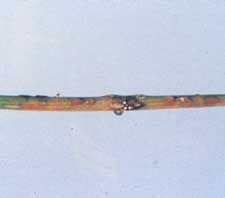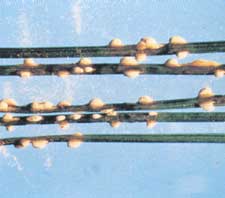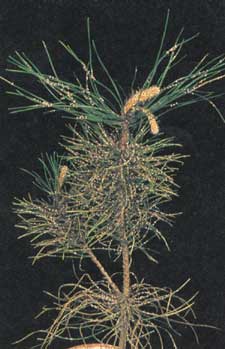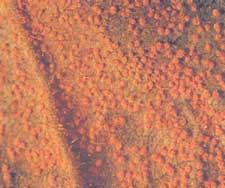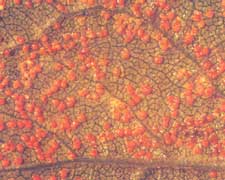Pine Needle RustsCordell C.E., Anderson R.L., Hoffard W.H., Landis T.D., Smith R.S. Jr., Toko H.V., 1989. Forest Nursery Pests. USDA Forest Service, Agriculture Handbook No. 680, 184 pp. Hosts PIne needle rusts, caused by spedes of Coleoasporium, affects two-and three-needle pines. They are most common on red, jack, lodge-pole, pitch, pond, Virginia, Monterey, loblofly, sand, shortleaf, slash, Austrian, pinyon, limber, spruce, longleaf, Table Mountain, and Scotch pInes. A variety of herbaceous plants, including goldenrod, aster, Iron weed, and species of Madia, Foresticra, Ribes, and Vernonia, serve as alternate hosts. Distribution Pine needle rusts occur on susceptible pines throughout the United States. Damage Although conspicuous, needle rusts usually do not cause serious problems in nurseries. When combined with insects and other agents that attack current-year foliage, however, needle rusts may seriously damage or kill seedlings.
Biology Most species of needle rusts need both a pine and a herbaceous host to complete their life cycle. Five spore states are produced. The pycnial and aecial states occur during the spring on pine needles. The aeciospores are windblown and infect the leaves of alternate hosts. The uredinial, telial, and basidial states develop on the alternate hosts in summer and autumn. Released from the telia in late summer and early autumn, windborne basidiospores infect pines. The fungi overwinter on pine needles; pycnia and aecia develop the following spring. Control Prevention - If possible, avoid locating nurseries where the alternate hosts grow abundantly. Do not transplant infected seedlings from other nurseries. Mechanically eliminate or mow alternate hosts adjacent to nursery beds. Alternate hosts within 1,000 feet of nursery beds should be sprayed with a registered herbicide. The alternate hosts should be eliminated before August, when infected plants normally produce basidiospores. Without their alternate hosts, the fungi will not be able to complete their life cycle. Establish barriers of nonsusceptible trees. The barriers should be 15 to 25 feet tall to intercept spores and to modify air currents so that fewer spores from the alternate hosts reach the pine seedlings. Coleosporium crowellii on pinyon pine and C. pinicola on Virginia pine do not require an alternate host and, unlike other needle rusts, can spread from pine to pine. Chemical - No fungicide is currently registered for control of pine needle rust. Selected Reference Nicholls, T.H.; Anderson. R.L. 1976. How to identify and control pine needle rust disease. St. Paul, MN: U.S. Department of Agriculture, Forest Service, North Central Forest Experiment Station. 8 p. |
Forest Pests: Insects, Diseases & Other Damage Agents |

|
|
